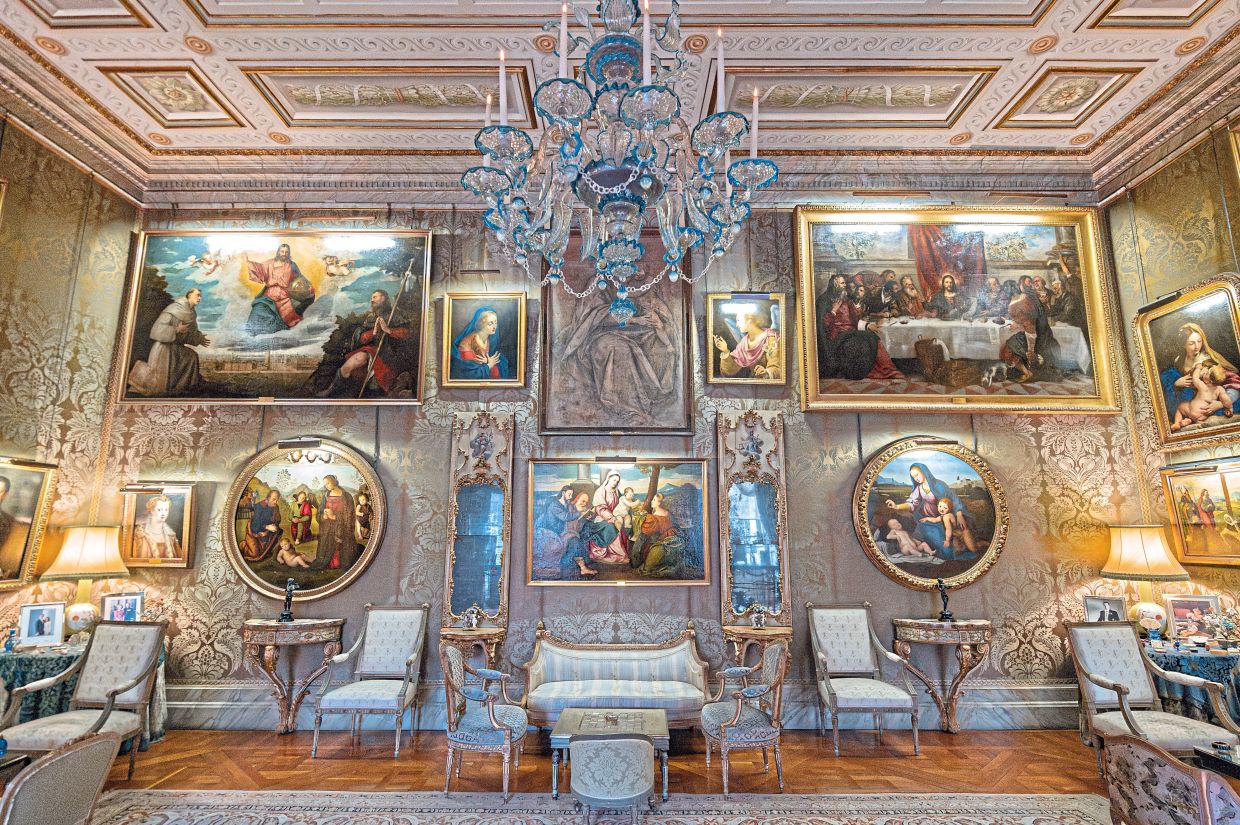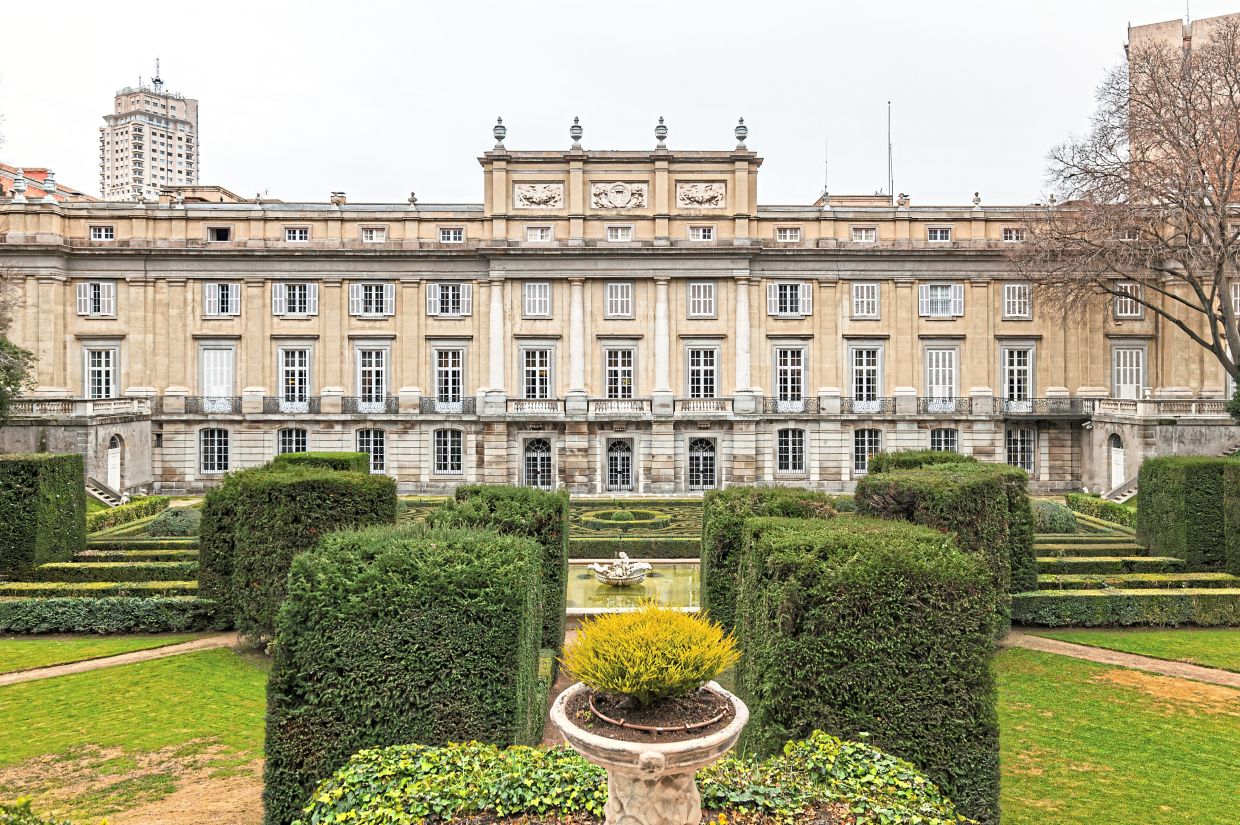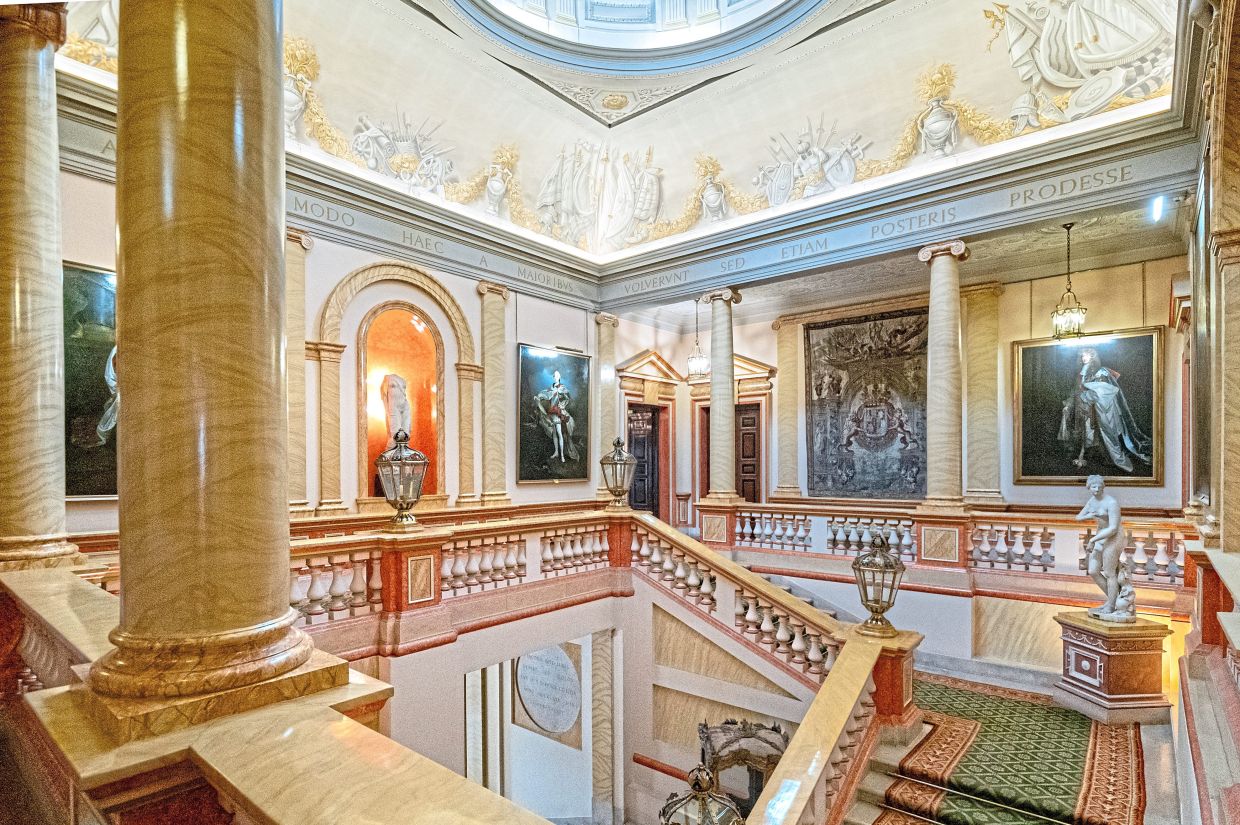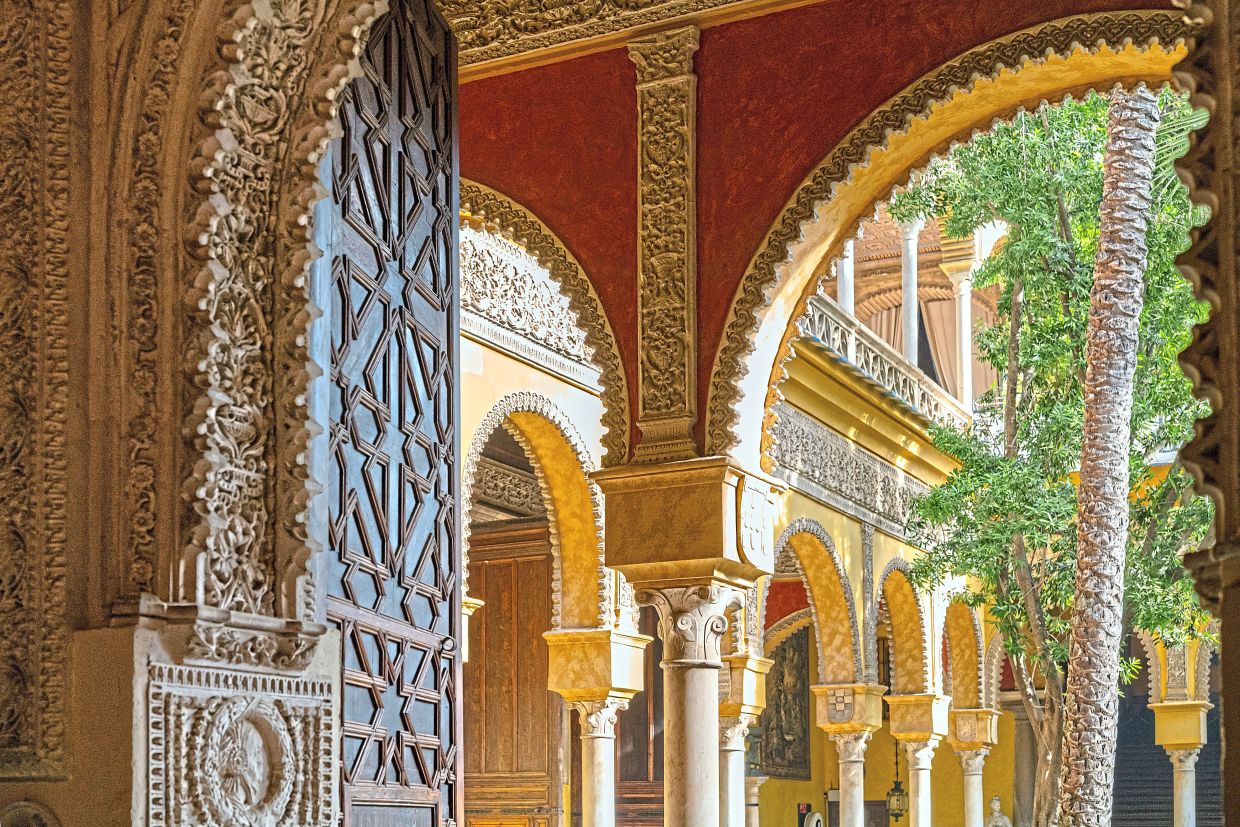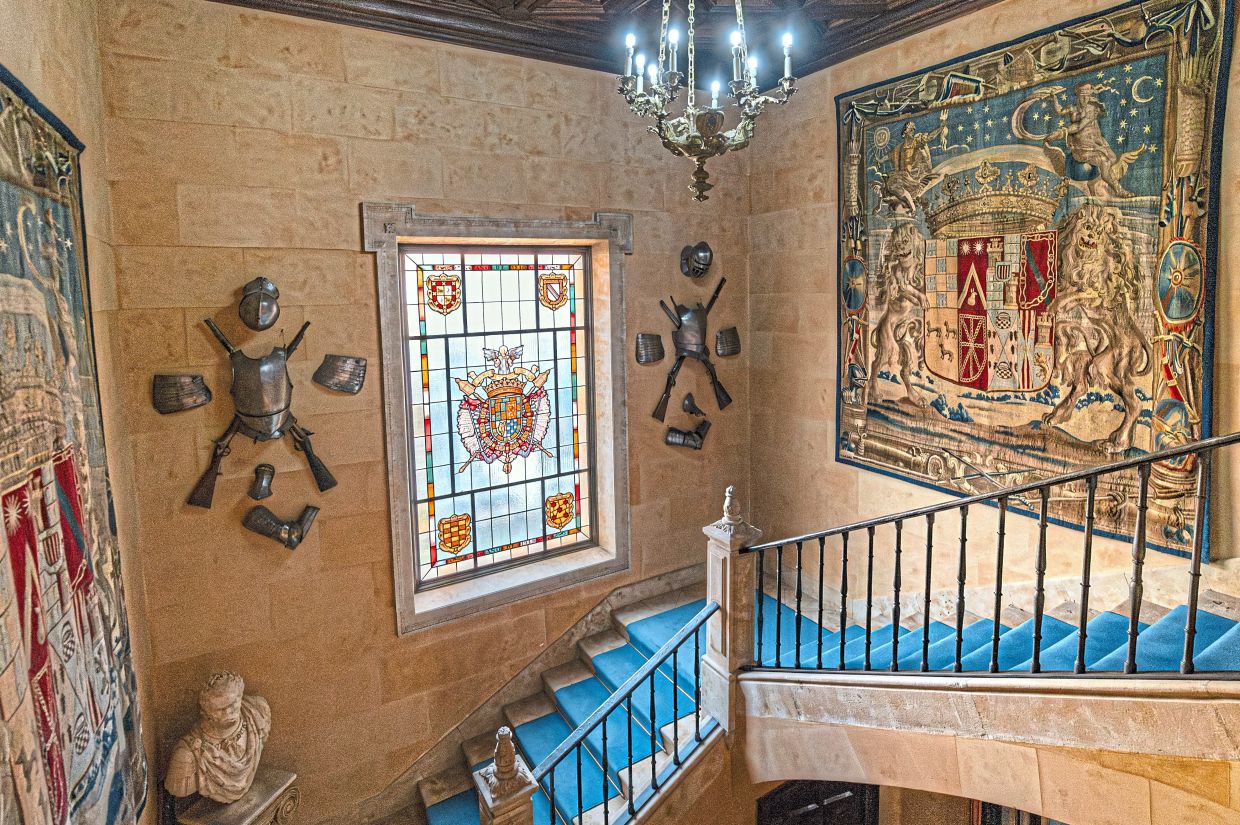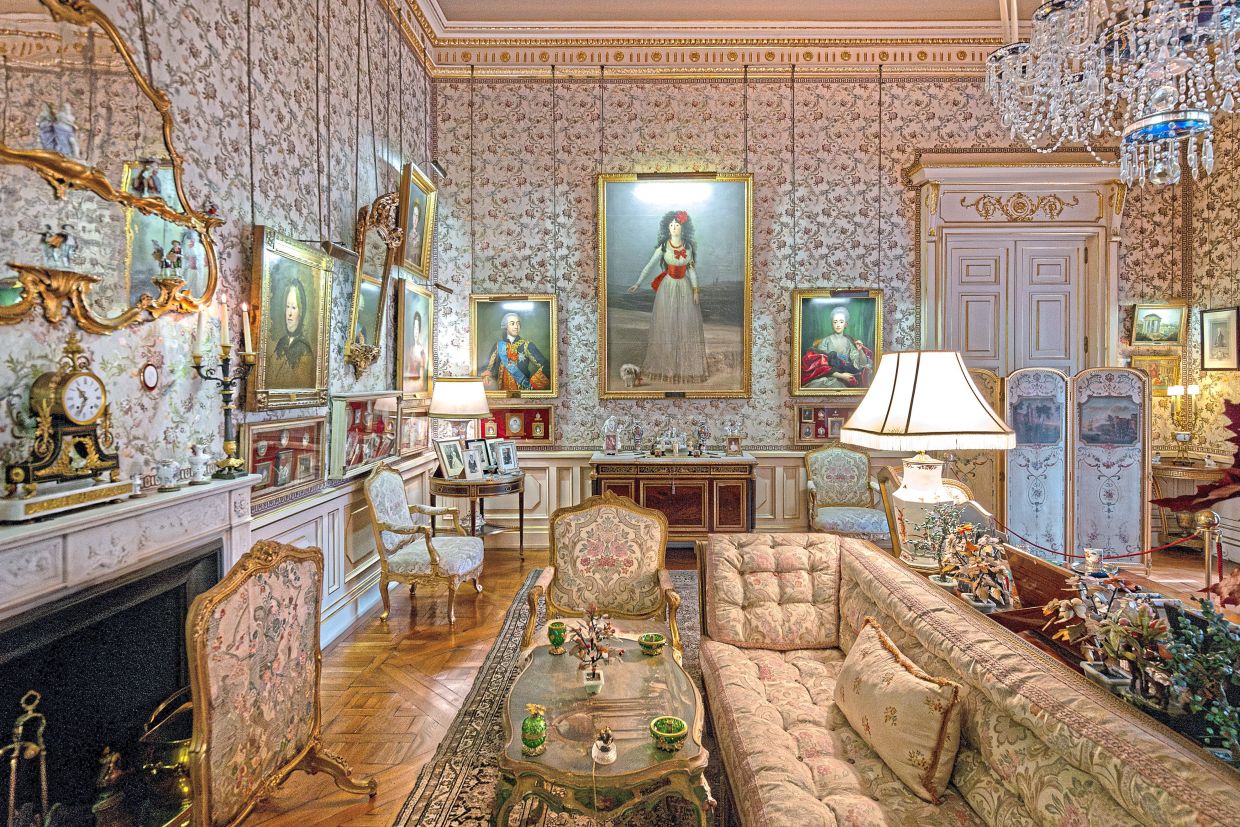The Italian Room, one of the Palacio de Liria’s themed living rooms that’s filled with paintings by Perugino, Titian, Guercino and other artists. — Photos: EMILIO PARRA DOIZTUA/NYT
One of the most important cultural events in Madrid, Spain in recent years was the public opening, just before the pandemic, of a collection that had been sitting behind the closed doors of a private palace for about 200 years.
The Palacio de Liria, the grand 18th-century home of the Alba family – among Spain’s (and Europe’s) oldest and most storied aristocratic families – is set in a tranquil garden just steps from the bustling Plaza de Espana in central Madrid. Often compared to the Prado Museum and the Royal Palace of Madrid for the masterpieces it contains and the noble residents who lived there, the house is filled with works by Titian, Rubens, Velázquez, Goya and other artists favoured by the Spanish court. There are also vast literary and historic archives, as well as letters written from the Americas by explorers Christopher Columbus, Francisco Pizarro and Hernán Cortés.
Since assuming the title in 2014, the 19th duke, Carlos Fitz-James Stuart, through the Casa de Alba Foundation, decided to share his family’s treasures with the world – an effort that began in 2015 with the opening of other singular family properties like the Palacio de las Duenas in Seville and the Palacio de Monterrey in Salamanca. Here is a tour of those three sumptuous palaces, along with a stop in the small town of Alba de Tormes.
A little background
The Duchy of Alba, created in 1472 when King Henry IV of Castile elevated Don García Alvarez de Toledo from count to duke, takes its name from an early family seat in Alba de Tormes, near Salamanca. Over the centuries, the dukes and duchesses of Alba have distinguished themselves in various ways. In the 16th century, the third duke, sometimes called the Iron Duke, was known for his military campaigns in the Eighty Years War. In the 18th century, the 13th duchess beguiled the painter Goya, who portrayed her several times.
Along the way, the Alba lineage became deeply intertwined with the lineages of other noble families. Titles were amassed. The 18th Duchess of Alba – whose name was Maria de Rosario Cayetana Paloma Alfonsa Victoria Eugenia Fernanda Teresa Francisca de Paula Lourdes Antonia Josefa Fausta Rita Castor Dorotea Santa Esperanza Fitz-James Stuart y Silva, Falco y Gurtubay – had more noble titles (more than 40) than first names. Dona Cayetana, as she was called, was the most titled aristocrat in the world and, until she died in 2014, kept the Alba name in the public eye, mostly by doing and dressing exactly as she pleased, sometimes scandalising an adoring public.
Her eldest son has kept a lower profile and so the three palaces he has opened retain the imprint of his mother’s passion for displaying family photos and tiny precious objects, enhancing the sense of home versus museum.
Palacio de Liria, Madrid
Screened from the street by towering cedars and ancient magnolias, the crisp, colonnaded Baroque facade of Liria can be glimpsed only when one is inside the garden. Designed primarily by architect Ventura Rodríguez in the late 18th century and largely rebuilt in the 20th, according to plans by British architecture heavyweight Edwin Lutyens, Liria Palace is the grandest Alba home and continues to be the duke’s principal residence, with family cars in the driveway and dogs frolicking on the lawn.
For €15 (RM76), visitors get a 65-minute audio tour of 14 glorious rooms, including the library, which houses, among other treasures, the oldest Bible in the Spanish language, a second edition of Cervantes’ Don Quixote and nearly half of Columbus’ extant correspondence – including his hand-drawn maps of Hispaniola from his voyage in 1492.
Beneath a luminous dome, the main staircase leads up to a gallery hung with portraits highlighting the family links to the Stuart monarchs of Britain. An enfilade of connected rooms reveals in astonishing succession the Alba family’s rich history as illustrated through a splendid art collection.
There’s a Flemish Room, with works by Rubens, Jan Brueghel the Elder and Jacob van Ruisdael, and a portrait of the third duke by Anthonis Mor, all of it illuminated by a Meissen chandelier dripping with pendulous clusters of deep purple porcelain flowers. The Italian Room stars Perugino, Palma Vecchio, Titian, Luca Giordano, Guercino and Andrea del Sarto beneath an equally stunning Murano chandelier. The Spanish Room has works by Velazquez, Zurbaran and Ribera, and the Goya Room has several works by the artist, including his portrait of the 13th Duchess of Alba, his friend and muse, perhaps the most famous work in the collection.
Palacio de Monterrey, Salamanca
The 16th-century Palacio de Monterrey (€9.50/RM48 for a 50-minute audio tour) illustrates the vicissitudes experienced by many noble dwellings. Its imposing facade suggests a splendid family home, albeit one a fraction of the size it was intended to be as financial constraints meant that only one wing was built. Marriage brought it into the Alba family around 1700.
While not as grand as intended, the facade is among the finest examples of the Spanish Plateresque architectural style, with its carved floral and figural motifs that animate the towers, cornices, windows and entrance.
The palace was used as a school in the 19th century and then left derelict until the interior was restored in the 1940s and 1950s by the 18th Duchess of Alba and her father. It is now the cosiest and most unpretentious of the three houses – though it does have a bedroom that was used by the former King Juan Carlos I, a family friend, as a teenager.
Among the most charming details is a mid-20th-century bathroom clad in 18th-century blue-and-white tiles, as well as a small study with William Morris wallpaper and art nouveau furniture. Dona Cayetana created the dried flower arrangements that adorn the dining room walls.
Aristocratic DIY projects aside, there are museum-quality works in virtually every room – including 17th-century Flemish tapestries and a pair of paintings found in a basement labelled “Italian school” that turned out to be the only two known landscapes by Spanish Baroque master José de Ribera.
Alba de Tormes
Little remains of the once splendid 16th-century Renaissance palace in Alba de Tormes, where operas and plays premiered for the third duke and his guests, who included King Ferdinand II of Aragon.
Today only a tower with some frescoes can be visited (entrance, €3/RM15). A climb to the top offers sweeping views of the gently rolling Castilian plains and the broad, slow meander of the Tormes River, suggesting what life may have looked like in 1582, when St Teresa of Avila, the Carmelite nun, mystic and philosopher, was summoned by the third duchess to bless the birth of their son. Heeding the duchess’s call despite being ill, St Teresa died soon after arrival and was buried in Alba de Tormes.
Church fathers in Avila insisted she be interred in her hometown and the body was returned.
However, at the request of a later duchess of Alba, a papal decree was granted for returning the saint to Alba de Tormes, where her body – or what is left of it – remains. On each transfer of her corpse, multiple body parts were taken to satisfy a flourishing market in saints’ relics. Her fingers, arms and heart and part of her jaw are all enshrined in far-flung churches. Her tomb in Alba de Tormes draws thousands of faithful visitors every year and requires five separate keys to open it, one of which is owned by the Duke of Alba; another is kept at the Vatican.
Palacio de las Duenas, Seville
The bougainvillea facade of the Palacio de las Duenas (entrance, €12/RM61) is a mind-blowing expanse of intensely coloured papery purple flowers clinging to the guest wing – and with more than 30 guest rooms, it adds up to a lot of purple. Within a year of its opening in 2015, Duenas became one of the top five most visited sites in Seville.
Built between the 15th and 16th centuries in the Renaissance style, it features Gothic and, especially, Moorish influences – most notably the concept that homes should appear fortress-like on the outside and paradisaical within. The palace’s layout includes 11 patios and gardens and nine fountains, including two tiled ones that have been gurgling away for nearly 500 years. Inside are works by 16th-century artists like Sofonisba Anguissola and Jacopo Bassano.
The Alba family acquired the house in 1612, when the previous owner needed ransom money to rescue a relative who had been kidnapped and taken to North Africa. Duenas was the 18th duchess’s favourite home, where, well into her 80s, she danced flamenco every morning for exercise. There’s even a flamenco-inspired room filled with her dresses as well as bullfighting memorabilia and other Andalusian relics. Poet Antonio Machado was born in the house when his father was the estate administrator, and he evokes its beauty in several poems.
Beyond the lush, jasmine-scented gardens, the walls and arcades are clad in acres of tile mosaic and stucco work. There are tapestries hung over the tiles and paintings hung over the tapestries, ratcheting up the sense of splendour.
There, in Duenas’ verdant and balmy embrace, it’s easy to become a little green with envy. – The New York Times
This article originally appeared in The New York Times.
Beautiful Spanish palaces
The Italian Room, one of the Palacio de Liria’s themed living rooms that’s filled with paintings by Perugino, Titian, Guercino and other artists. — Photos: EMILIO PARRA DOIZTUA/NYT
In Madrid, the Italian Room, one of the Palacio de LiriaÕs themed living rooms, is filled with paintings by Perugino, Titian, Guercino and other artists. (Emilio Parra Doiztua/The New York Times)
The rear facade of the Palacio de Liria in Madrid, the grandest Alba home and continues to be the 19th (and current) duke’s principal residence.
The Palacio de Liria is the grandest Alba home and continues to be the 19th (and current) dukeÕs principal residence. (Emilio Parra Doiztua/The New York Times)
A bathroom, clad in 18th-century blue-and-white tiles, in the Palacio de Monterrey in Salamanca.
A bathroom in the Palacio de Monterrey is clad in 18th-century blue-and-white tiles. (Emilio Parra Doiztua/The New York Times)
The main staircase of the Palacio de Liria.
The main staircase of the Palacio de Liria in Madrid. (Emilio Parra Doiztua/The New York Times)
In the town of Alba de Tormes, Spain, for which the Alba family was named, a centuries-old tower offers views of the surrounding landscape.
In the town of Alba de Tormes, Spain, for which the Alba family was named, a centuriesold tower offers views of the surrounding landscape. (Emilio Parra Doiztua/The New York Times)
The interior of the centuries-old tower in the town of Alba de Tormes.
Visitors can explore the tower in Alba de Tormes, which contains Renaissance frescoes. (Emilio Parra Doiztua/The New York Times)
A fountain at the Palacio de las Duenas in Seville. The palace has 11 patios and gardens and nine fountains, including two tiled ones.
The Palacio de las Due–as has 11 patios and gardens and nine fountains, including two tiled ones. (Emilio Parra Doiztua/The New York Times)
An entrance gate to the Palacio de las Duenas. The palace, which opened to the public in 2015, is one of the most visited sites in Seville.
Palacio de las Due–as, which opened to the public in 2015, is one of the most visited sites in Seville. (Emilio Parra Doiztua/The New York Times)
The Palacio de las Duenas was built between the 15th and 16th centuries in the Renaissance style.
Built between the 15th and 16th centuries in the Renaissance style, the Palacio de las Due–as in Seville, Spain, features Gothic and, especially, Moorish influences. (Emilio Parra Doiztua/The New York Times)
A staircase in the Palacio de Monterrey.
In the Palacio de Monterrey in Salamanca, museumquality works, including Flemish tapestries, are numerous. (Emilio Parra Doiztua/The New York Times)
The Goya Room in the Palacio de Liria has several works by the artist, including his portrait of the 13th Duchess of Alba, his friend and muse.
The Goya Room has several works by the artist, including his portrait of the 13th Duchess of Alba, his friend and muse. (Emilio Parra Doiztua/The New York Times)



